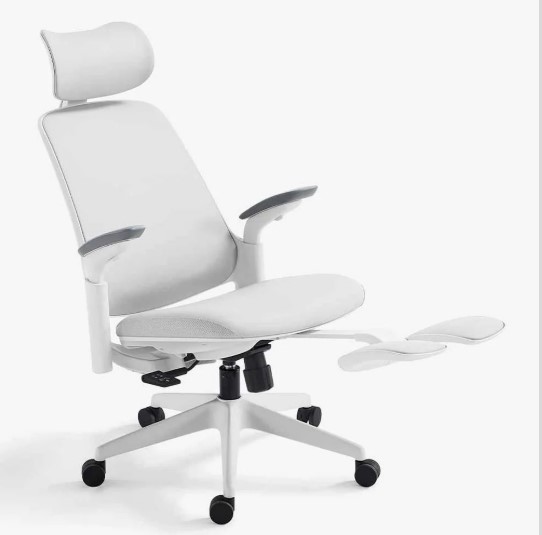In modern lifestyles, the prevalence of back pain has been steadily increasing, becoming a significant concern for individuals of all ages. Technological advancements, sedentary work habits, and changes in daily routines have contributed to this rising trend. The lack of physical activity, prolonged periods of sitting, and poor posture while using electronic devices have collectively led to a higher susceptibility to back pain.
Moreover, the fast-paced nature of modern life often leaves individuals with limited time to focus on their physical well-being. As a result, they might neglect proper exercise, stretching, and ergonomic practices, all of which are crucial in maintaining a healthy spine and preventing back pain.
Back pain affects an individual’s comfort, productivity, mental well-being, and overall quality of life. Addressing this issue requires a comprehensive approach involving ergonomics, regular exercise, posture awareness, and lifestyle balance that is essential for back comfort.
Preventing and managing back pain hinges on ergonomic factors. Ergonomics involves designing and organising the environment to cater to individual needs, and it plays a crucial role in how our bodies engage with daily spaces and tools.
- Optimal Spinal Alignment: Ergonomically designed workspaces promote proper spinal alignment, reducing stress on the vertebrae, discs, and back muscles. Keeping your spine’s natural curves intact while sitting and working helps distribute weight evenly and minimises the risk of strain and discomfort.
- Muscular Support: Proper ergonomics encourage the engagement of core muscles, which play a vital role in supporting the spine. When ergonomic principles are followed, muscles are less likely to become fatigued or overworked, reducing the likelihood of muscular imbalances contributing to back pain.
- Reduced Strain: Ergonomic adjustments, such as adjusting chair height, desk height, and monitor placement, reduce strain on various body parts. It minimises strain on the neck, shoulders, and lower back, commonly affected by poor posture and incorrect workstation setups.
- Prevention of Repetitive Strain Injuries: Ergonomics helps prevent repetitive strain injuries (RSIs) by promoting movements that reduce stress on specific muscles and joints. This is particularly important in the context of desk jobs or tasks that involve repetitive motions.
- Improved Blood Circulation: Ergonomic setups promote healthy blood circulation by preventing compression of blood vessels and nerves, which can occur when sitting in awkward positions for prolonged periods. Proper ergonomics can help prevent numbness, tingling, and discomfort due to restricted blood flow.
- Enhanced Productivity and Focus: When individuals are comfortable and pain-free in their work environment, they can focus r on their tasks and perform better. Discomfort and pain can lead to distractions, reduced concentration, and decreased productivity, all of which can be mitigated through ergonomic adjustments.
- Long-Term Health Benefits: Proper ergonomics prevent immediate discomfort and contribute to long-term musculoskeletal health. By adopting ergonomic practices, individuals can reduce the risk of chronic back pain, herniated discs, and other spinal issues that may arise from poor posture and incorrect body mechanics.
- Empowerment of Individuals: Understanding and implementing ergonomic principles allows individuals to take charge of their well-being. Individuals can actively contribute to their back health and overall quality of life by making conscious choices about workspace setup, posture, and movement.
Making ergonomic changes to everyday habits and work environments can notably decrease both the frequency and intensity of back pain. By prioritising ergonomics, individuals can proactively manage their back health and create an environment that supports their overall well-being.
Understanding the Impact of Back Pain
Back pain is a pervasive and often debilitating condition that can profoundly impact an individual’s physical, emotional, and social well-being. Understanding the impact of back pain is essential to recognise its significance and take proactive steps to manage and prevent it. Here are some critical aspects of the impact of back pain:
Physical Discomfort and Limitations:
- Back pain can cause varying degrees of discomfort, ranging from mild aches to intense, sharp pain.
- Individuals with back pain may experience limitations in their ability to perform everyday activities, such as bending, lifting, walking, and even sitting for extended periods.
- Severe back pain can lead to reduced mobility and contribute to a sedentary lifestyle, further exacerbating the issue.
Reduced Quality of Life:
- Chronic back pain can significantly diminish an individual’s quality of life. Activities that were once enjoyable or routine can become painful or impossible to perform.
- Sleep disturbances are common among those with back pain, leading to fatigue and a decreased overall sense of well-being.
Impact on Mental Health:
- Back pain is often linked to psychological distress, including anxiety, depression, and feelings of helplessness.
- Coping with persistent pain can lead to stress and negatively affect mental health, contributing to a cycle of pain and emotional strain.
Work-related Challenges:
- Back pain can lead to absenteeism and reduced work productivity. Individuals may need to take time off work or modify their tasks to accommodate their pain.
- Job satisfaction and career advancement can be compromised when back pain interferes with job performance.
Financial Burden:
- The costs associated with treating and managing back pain can be significant. These include medical expenses, rehabilitation, medications, and potential changes to lifestyle and work arrangements.
- Lost income due to missed work can also impact an individual’s financial stability.
Social Isolation:
- Chronic back pain can lead to decreased social engagement and participation in recreational activities. Individuals may withdraw from social interactions due to discomfort or limitations.
- The emotional toll of back pain can also strain relationships, as family and friends may struggle to understand the extent of the pain and its effects.
Risk of Disability:
- If not managed correctly, chronic back pain can escalate to a point where it becomes a disabling condition, preventing individuals from engaging in daily activities and maintaining their independence.
Healthcare Utilization:
- Individuals with back pain may seek medical attention, leading to increased healthcare utilisation, appointments, and treatments. This can strain healthcare systems and resources.
Understanding the multifaceted impact of back pain underscores the importance of proactive prevention and effective management strategies. Emphasising ergonomic practices, maintaining a healthy lifestyle, staying physically active, and seeking timely medical intervention can significantly reduce the adverse effects of back pain and improve overall well-being.
Ergonomics and Its Role in Back Pain Management
Ergonomics plays a crucial role in the management of back pain by addressing the root causes of discomfort and promoting optimal body alignment and movement. By designing workspaces, equipment, and tasks to fit the capabilities and limitations of the human body, ergonomic principles contribute to the prevention and alleviation of back pain. Here’s how ergonomics is essential for back pain management:
Promotes Proper Posture:
- Ergonomics encourages individuals to maintain correct posture while sitting, standing, and performing various tasks.
- Proper posture helps distribute body weight evenly and reduces strain on the spine, minimising the risk of developing or worsening back pain.
Reduces Muscular Strain:
- Ergonomic designs consider the body’s natural movements and aim to minimise unnecessary strain on muscles and joints.
- Adjusting chair height, desk height, and monitor position helps prevent overuse of specific muscles, which can contribute to muscular imbalances and back pain.
Supports Spinal Alignment:
- Ergonomically designed chairs and workstations support the spine’s natural curvature, maintaining its proper alignment.
- A well-aligned spine reduces pressure on intervertebral discs, nerves, and surrounding tissues, reducing the risk of back pain and related issues.
Encourages Movement:
- Ergonomics emphasises the importance of regular movement and avoiding prolonged periods of static posture.
- Dynamic sitting, where individuals shift positions and move throughout the day, helps prevent stiffness and promotes blood circulation, aiding back pain management.
Minimises Repetitive Strain:
- Ergonomic setups consider the repetitive nature of certain tasks and seek to reduce strain on muscles and joints exposed to repetitive motions.
- Adjustments in workstation layout and tools can help prevent repetitive strain and injuries contributing to back pain.
Personalised Solutions:
- Ergonomics recognises that individuals have varying body types, sizes, and needs.
- Customisable furniture and equipment allow individuals to adapt their work environment to their unique requirements, minimising discomfort and promoting back health.
Enhances Comfort and Productivity:
- An ergonomic workspace fosters comfort, positively impacting an individual’s focus, concentration, and overall productivity.
- Comfortable individuals are less likely to experience distraction due to pain, leading to improved work performance.
Prevents Cumulative Trauma:
- Cumulative trauma, resulting from repeated microtraumas over time, can contribute to chronic back pain.
- Ergonomic interventions help mitigate these microtraumas by promoting proper movement patterns and reducing the strain caused by poor posture.
Long-term Back Health:
- By adopting ergonomic practices, individuals can proactively contribute to their long-term back health and reduce the risk of developing chronic back pain and spinal disorders.
Incorporating ergonomic principles into daily routines and work environments is an effective strategy for managing and preventing back pain. By aligning the physical demands of tasks with the body’s capabilities, ergonomics empowers individuals to reduce discomfort, enhance productivity, and promote overall well-being.
Elements of an Ergonomic Workspace
Creating an ergonomic workspace involves optimising various elements to ensure comfort and efficiency. Keep these key components in mind when designing an ergonomic workspace aimed at preventing and alleviating back pain:
Ergonomic Chair:
- Select a chair with suitable lumbar support to sustain the natural arch of your lower back.
- Look for chairs with adjustable features, including seat height, backrest angle, and armrest height.
- You should be able to sit on the chair with your feet flat on the floor and knees at a 90-degree angle.
Desk and Work Surface:
- Adjust the desk height so that your elbows form a 90-degree angle when typing and your wrists remain in a neutral position.
- Ensure there is enough space under the desk to comfortably position your legs and feet.
Monitor Placement:
- Position the monitor at eye level to prevent neck strain. The top of the screen should be at or just below eye level.
- Keep the monitor at a comfortable viewing distance to avoid leaning forward or straining the eyes.
Keyboard and Mouse Setup:
- Use a keyboard tray or a desk with a pull-out keyboard drawer to ensure proper arm and wrist alignment.
- Keep the keyboard and mouse close to your body to minimise reaching.
Foot Support:
- Use a footrest if your feet don’t comfortably reach the floor.
- Ensure your feet are well-supported to help maintain proper posture and reduce lower back strain.
Monitor Stand or Arm:
- Utilise an adaptable monitor mount to place the display at an optimal height and distance.
Lighting:
- Ensure proper lighting to reduce eye strain. Avoid glare and position light sources evenly to illuminate the workspace.
- Consider using a desk lamp with adjustable brightness and direction.
Accessories and Tools:
- Use ergonomic accessories, such as a document holder, to position reference materials at eye level.
- Invest in ergonomic tools, such as an ergonomic keyboard and mouse, to reduce strain on hands and wrists.
Cable Management:
- Organise and manage cables to prevent them from becoming tripping hazards or causing clutter.
Personal Items and Arrangements:
- Keep frequently used items within easy reach to avoid excessive stretching or twisting.
- Organise your workspace to minimise clutter and create a calm and focused environment.
Movement and Breaks:
- Incorporate movement breaks into your routine. Stand, stretch, and walk around periodically to prevent stiffness.
- Consider using a sit-stand desk to alternate between sitting and standing positions.
Chair and Desk Accessories:
- Consider using ergonomic cushions, lumbar supports, and seat cushions to enhance comfort and support.
- Use a footrest or footstool if needed for proper leg and foot support.
Creating an ergonomic workspace involves tailoring each element to your body’s needs and comfort. Regularly adjusting and fine-tuning your workspace setup can help you maintain good posture, reduce strain, and prevent or alleviate back pain caused by poor ergonomics.
Role Of Individual Responsibility In Maintaining Proper Ergonomic Practices
Maintaining proper ergonomic practices in the workspace is a shared responsibility between individuals and their employers. Individuals play a crucial role in prioritising their well-being and taking proactive steps to prevent and manage back pain through ergonomic practices. Here’s an emphasis on the role of individual responsibility in maintaining proper ergonomic practices:
Awareness and Education:
- Individuals should educate themselves about proper ergonomic principles and understand how to set up their workspace for optimal comfort and support.
- Stay informed about the potential risks of poor ergonomics, including back pain and other musculoskeletal issues.
Self-Assessment:
- Regularly assess your posture and comfort while working. Pay attention to any discomfort or signs of strain.
- Adjust your workstation as needed to maintain proper alignment and prevent discomfort.
Proactive Adjustments:
- Take the initiative to adjust your chair, monitor, keyboard, and other equipment to fit your body’s dimensions and needs.
- Regularly reassess and fine-tune your setup to ensure it remains ergonomically sound.
Movement and Breaks:
- Incorporate movement into your routine. Stand, stretch, and change positions periodically to prevent stiffness and improve circulation.
- Follow the 20-20-20 rule: Every 20 minutes, look at something 20 feet away for at least 20 seconds to reduce eye strain.
Healthy Work Habits:
- Avoid prolonged periods of sitting. Get up, walk around, and perform light stretches throughout the day.
- Practice good sitting and standing posture, engaging your core muscles to support your spine.
Communication with Employers:
- Communicate any discomfort, pain, or ergonomic challenges you’re facing with your employer or HR department.
- Work together to find solutions that support your well-being and productivity.
Lifestyle Considerations:
- Pay attention to your overall lifestyle. Consistent exercise, a balanced diet, and staying hydrated contribute to your overall physical well-being and can impact your comfort at work.
Personalisation of Workspace:
- Personalise your workspace with ergonomic accessories that enhance your comfort and support, such as lumbar cushions or footrests.
- Organise your space to minimise clutter and distractions.
Continuous Learning:
- Stay open to learning more about ergonomics and how it can benefit your health and productivity.
- Seek resources, articles, and workshops to deepen your understanding of proper ergonomic practices.
Lead by Example:
- Encourage your colleagues to adopt proper ergonomic practices by setting an example.
Share your knowledge and experiences to create a culture of well-being within your workplace.
Ultimately, maintaining proper ergonomic practices requires consistent effort and mindfulness. By taking responsibility for your well-being and actively implementing ergonomic principles, you can significantly reduce the risk of back pain and related discomfort, contributing to a healthier and more productive work environment.
















